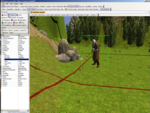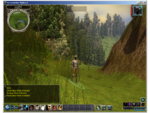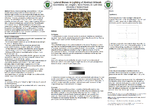Professional
Capsized - Usability/User Experience Specialist
Capsized is a side-scrolling platformer, set in the future. Currently, I'm the Usability Consultant for the project although I will be doing some freelance development as well. The game is the brain child of LeeVermeulen and Jesse McGibney. Both are extremely talented individuals and I'm incredibly lucky to be working with them. I'm really excited to be working on this project.
Critic-Proofing
The role of a video game critic is complex, but one thing is clear; their insight is always valuable. Critics and the ratings they assign to games have some real and important effects on individuals in the games industry, for example some publishers have metascores to determine when and how bonuses will be paid.
I have developed and published a technique that I call critic-proofing. The technique uses usability data mined from game reviews and the genre of the game being evaluated to weight the severity of problems identified during a usability evaluation. The historical data ensures a more robust results, the process produces an ordered list of usability problems.
I have published two papers on the critic-proofing technique. The first describes the technique and explores a case study. The second describes a system design for the large-scale development and deployment of a machine learning system. The system is based on the mining of a large video game review data set.
Discount Game Evaluation
This project extents my recently published work on critic-proofing. Heuristic evaluation is a cheap, fast, and effective method of software evaluation. The problem is the process relies on the subjective assessment of the evaluators. The critic-proofing process removes some of the subjectivity by assigning priority ratings bases on the genre of the game.
This new project extends the critic-proofing process further by combining it with the agile development process. Heuristic evaluation fits well with agile processes, while the critic-proofing technique can be used as a metric measurement for management.
Linguistic categorization
Previously it has been shown that many personality traits can be determined through the evaluation of the language people use. This same technique has been used in blog categorization, and deception in instant messaging. In this project I plan to explore the language used in online video game chat-logs to explore player personality and type.
Persuasive Game Test-Bed
When talking with gamers, the suggestion that a game could include a physically active component is often meet with zealous opposition. This, however, hasn't prevented the success of a number of video games that promote physical activity, e.g. Dance Dance Revolution, or Wii Fit.
Unfortunately, there are a two of problems with these systems. Firstly, players must be active while playing the game itself, and Secondly, The games only encourage activity during the play session. For these reasons, these games only really offer players a different way to play, not a reason to change their daily activities.
The goal in this project was to develop a Video Game Test-bed that encourages players to change their daily activities in a healthy way without forcing players to be active while playing. This is accomplished with a system of in-game rewards for out-of-game activities.
The game needed to be engaging and compelling enough that players would actually desire the rewards, and want to play. To accommodate this, an RPG game was developed using the Neverwinter Nights 2Toolset. This toolset offers a large range tools for scripting, map building, visual effects, and multiplayersupport.
 Electron Toolset forNeverwinter Nights 2The game has three primary components, player vs. environment for character leveling, player vs. player using solely in-game progression, and player vs. player using solely out-of-game progression. The distinction was made by providing the players with two characters at all time. One they created in game, and controlled directly. The other an animal companion whose progression was dependant on a players out-of-game activities, and was only controlled by the player during the second player vs. player scenario.
Electron Toolset forNeverwinter Nights 2The game has three primary components, player vs. environment for character leveling, player vs. player using solely in-game progression, and player vs. player using solely out-of-game progression. The distinction was made by providing the players with two characters at all time. One they created in game, and controlled directly. The other an animal companion whose progression was dependant on a players out-of-game activities, and was only controlled by the player during the second player vs. player scenario. Game EnvironmentScreenshot
Game EnvironmentScreenshot
Currently, data is being analysed. The results of this study will be published shortly.
 This is a copy of a presentation I made for this project. It may not make much sense just reading it, the slides were intentionally minimalist. I may make this into a video at a later date.
This is a copy of a presentation I made for this project. It may not make much sense just reading it, the slides were intentionally minimalist. I may make this into a video at a later date.
Abstract - How using critic reviews and game genres can refine heuristic evaluations
Heuristic evaluation - a technique where experts inspect software and determine where the application violates predetermined policies for good usability - is an effective technique for evaluating productivity software. The technique has recently been applied to video games, examining playability and usability for both single and multiplayer games. However, the severity ratings assigned to usability problems and used as a coarse categorization method for triage are still subjectively and somewhat arbitrarily assigned by evaluators, offering limited organizational value. In addition, they fail to account for the diversity found between games and game genres. In this paper we present a modified heuristic evaluation technique, which produces a prioritized list of heuristic violations based on the problem's frequency, impact, persistence, the heuristic it violates, and the game's genre. We evaluate our technique in a case study and show that the technique provides substantial value with little additional effort.
Livingston, I. J., Mandryk, R. Stanley, K., Critic-Proofing: How Using Critic Reviews and Game Genres can Refine Heuristic Evaluations, In Proceedings of Future Play 2010, Vancouver, Canada. 72-79.
Abstract - Robust validation through data-mining
Critic-proofing is a modified heuristic evaluation technique, specifically designed to provide a fine-grained, prioritized list of heuristic violations. The critic-proofing technique weights the severity of a problem based on the frequency that similar problems are found in similar games. The severity ratings are calculated using data collected from game reviews, and the severity assigned to a problem during the heuristic evaluation process. However, heuristic techniques have had limited adoption within the video game industry. One reason for this is the perceived lack of validity and robustness of game specific heuristic principles. In this paper, we introduce and outline a new data- mining project designed to validate game-specific heuristic techniques, especially the critic-proofing technique by using the popular game-review aggregation website Metacritic.
Livingston, I.J., Nacke, L.E., Mandryk, R.L. (2010). Critic-Proofing: Robust Validation Through Data-Mining. In Playability and player experience: Proceedings of the Fun and Games 2010 Workshop, pp.81-94, NHTV Expertise Series 10.
Book Order PDF 
Pinizoro - GPS iPhone Game
Pininzoro was a side project and collaboration between Kevin Stanley, Regan Mandryk, and myself. At a very over simplified level the project set out to explore to what degree mobile platforms could be used as a device to stimulate physical activity in children. It is well known that obesity is a growing problem in children across North America. Pinizoro is an attempt to gadge the effects of using video games as a tool to develop positive physical habits for children, parents, and families.
While the initial idea and system development is not my own, I was instrumental in the game design, testing, and evaluation of the system.
Abstract
Obesity is a growing problem among children, due in part to their sedentary lifestyles. Time spent engaged in physical activity is decreasing, while time spent playing computer and video games is on the rise. We leverage children’s interest in digital games to encourage families to engage in purposeful walking. We present a GPS-based game, played on a mobile device that uses walking as a primary gameplay mechanic. Our game, PiNiZoRo, includes a fighting game, triggered at points along a real-world route, and a map editor that allows parents and recreation specialists to create custom routes in their neighbourhoods. Results from an initial focus group with parents were positive, as they showed enthusiasm for the concept, implementation, and gameplay.
Stanley, K., Livingston, I., Bandurka, A., Kapiszka, R., Mandryk, R.L. 2010. PiNiZoRo: A GPS-based Exercise Game for Families. In Proceedings of Future Play 2010, Vancouver, Canada. 1-4.
Lateral Biases in Lighting of Abstract Artwork
This project is a joint effort between myself and David McDine, a graduate student here at the University of Saskatchewan. Our work has recently been accepted for publication in a future issue of Laterality. When the article is finally published I'll provide a link.
The work explored a phenomenon known as lateral bias. Previous studies have shown that there is generally a left lateral bias in lighting. That is to say light usually comes from the left, and from above. This has been observed, for example, in magazine advertising where it has been shown that the majority of cases are lit from the top left (don't believe me? grab the nearest magazine and see how many images are lit from the right. Not many right?).
Our study tried to determine the nature and severity of this bias, and to determine if this is something that humans do naturally. Participants in our study were asked to light a series of abstract images on a computer using a virtual light. The results confirmed our hypostatise, participants lit the images from the top left significantly more than from anywhere else, this was true regardless of the images orientation.
I developed a custom graphical application for this project using C++ and GLSL. The goal was to produce a program with high visually quality, and robust logging and data collection to explore lateral bias in humans. This program uses a 'virtual flashlight' as an experimental tool; a technique that has not previously been explored or leveraged in this field of study.
Abstract
Previous studies examining perceptual biases in art have revealed that paintings tend to be lit from above and to the left. Abstract images provide a way of testing for the left-light bias while controlling for cues such as posing biases, ground line, shadows, and reflections. A total of 42 participants completed a task that required moving a ‘‘virtual flashlight’’ across the surface of abstract images presented on a computer screen: 20 images (presented both right-side-up and upside down) were used in the study. The participant’s only instruction was to ‘‘light the painting in a way that is most aesthetically pleasing to you’’. As predicted, participants on average focused the ‘‘virtual flashlight’’ in the top left quadrant. This study reveals that lateral lighting biases in artwork are not dependent on perception of local light source or interactions with discrete, concrete visual representations in the artwork.
- Poster Presentation at Tennet 2009 Theoretical & Experimental Neuropsychology
Publication
McDine, David A. , Livingston, Ian J. , Thomas, Nicole A. and Elias, Lorin J.(2010) 'Lateral biases in lighting of abstract artwork', Laterality: Asymmetries of Body, Brain and Cognition, First published on: 09 June 2010
<doi:10.1007/978-1-84882-854-4_20>
Character Sharing - Collaboration in Massively Multiplayer Online Games
Everyone knows that people share accounts and characters in many games. We looked at how players actually share characters in World of Warcraft, a practice which is strictly against the EULA. We surveyed over 1000 players and collected accounts of the many ways that players share their characters. We published out findings in ECSCW, and the publication is available below.
Abstract
Many online games are played through characters that act out players’ intentions in the game world. The practice of character sharing – allowing others to use one’s characters, or using others’ – is prohibited in many RPGs, but anecdotal evidence suggests that the practice is common, and that it may play an important role in the game. To shed light on this little-known form of collaboration, we carried out a large-scale survey study to investigate character sharing in one RPG, World of Warcraft. We analyze and report on 1348 responses, providing a detailed picture of sharing practices and attitudes. We found that character sharing is common (57% of respondents reported sharing) and that sharers have a wide variety of motivations and concerns. In addition to showing how character sharing works, the study also provides new perspectives on several themes in CSCW, including conceptions of sharing, online identity, and mediating artifacts.
Publication
Wong, N., Tang, A., Livingston, I., Gutwin, C., Mandryk, R. (2009), Character Sharing in World of Warcraft, Proceedings of the European Conference on Computer-Supported Cooperative Work (ECSCW'09), 343-362.
<doi:10.1007/978-1-84882-854-4_20>
Spatial Memory & Field of View
The human visual processing system is complex and often subtle differences in a test can produce a large changes in the result. When it comes to spatial memory it has been found that large and significant differences exist between men and women, with women outperforming men in both object location and object name. Research has also shown that there is a difference in how visual information is processed in the upper and lower visual fields.
In this project we explore the effects of sex, and visual fields on object location memory.
Due to inconclusive data this project has currently been put on hold. In the future I'd like to return to this project due to the conflicting nature of the results. Prior work has shown that there is a significant difference between men and women in spatial aptitude, and differences in spatial ability in peri-personal and extra-personal space. Since this project is no longer my thesis it has taken a backseat to more current projects.
Status - On Hold
CMPT 481 - Human Computer Interaction
This was a experimental project developed and run during the undergraduate HCI class at the University of Saskatchewan.
Cross Display Mouse Movement MDEs
Abstract
Multi-display environments are becoming more common in both homes and offices. The movement between displays is common in these settings and we should strive to optimize the action. The stitching technique causes the cursor to jump form one display to another, instantly, regardless of the displayless space between displays. In this paper we examine three techniques that attempt to provide benefits for the standard stitching techniques used in most operating systems today. Two of the techniques apply a pseudo-haptic effect to the cursor, slowing the movement, when moving from one display to another. The last technique applies a visual cue to the cursor when crossing from one display to another. Each of these techniques is examined for different distances between displays. We carried out an experiment attempting to discover which technique is optimal for cross-display movement. We found that the visual cue technique was equivalent to stitching at all distance for task completion time, but both pseudo-haptic effects were significantly slower. We also found that at medium and larger distances between displays all three techniques were significant in their reduction of target overshoot. Target overshoot occurs when the cursor is moved beyond the desired target location. These finding suggest that there is a practical advantage for providing a visual cue to users when passing from one display to another.
CMPT 463 - Advanced Algorithms
The project in this class involved examining a recently published technique, and present the finding in a easy to read synopsis with example. The paper I reviewed was titled 'Euclidean Voronoi Diagrams for Circles in a Circle' by D.-S. Kim, D. Kim, and K. Sugihara. I choose this paper because I found it both interesting, and appealing.
Euclidean Voronoi Diagrams for Circles in a Circle Synopsis
CMPT 470 - Advanced Software Engineering
This was a term project designed to explore the topic of effective interface design. The project was only loosely connected to the topics from the class, however the instructor was supportive of my research ambitions and allowed me some leeway. The experiment was designed to evaluate visual search differences between men and women; with the hypothesis that women would have an advantage over men. However, the project received a major overall and evolved into the Spatial Memory & Field of View project, in the summer following the class. Since the project is still ongoing the paper does not include any results.
Female Performance Advantage When Using a Standard Interface Design
Personal
D&D 4th Edition Campaign
In a previous campaign I created and ran there were two very interesting player-characters. One was named Jake, the other Gill. The game was and epic level using the 3.5 edition rule set, and it was a lot of fun for all involved.
Jake was a fascinating character, a little halfling who believed in nothing but fate, luck (an odd mix), and his own skills. Gill was also a halfling; she hated most anyone who wasn't halfling and generally had a rather grim outlook on life. This was due, primarily, to poor Gill's constant and unfortunate deaths, and subsequent resurrections. Ironically, and unknown to Jake, Gill was charged by the gods to keep Jake safe from harm.
The story ended with the two friends fleeing the city of Riverstone with a group of halflings. Their future adventures unknown to the world.
The new game follows on from this game and is set hundreds of years in the future. Jake and Gill continued on their journey in grand fashion, though their eventual fate is unknown. However, there are a few scholarly folk who know that there was more to the tale of Jake and Gill. In fact, the nursery rhyme told to children is believed to be the story of their adventure, though no one knows for sure what really happened to the two heroes, or what the rhyme really means...





